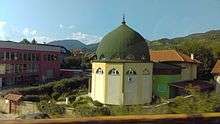Islam in Bosnia and Herzegovina
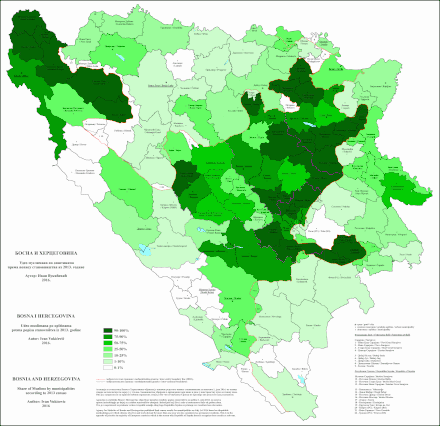
Islam is the most widespread religion in Bosnia and Herzegovina. It was introduced to the local population in the 15th and 16th centuries as a result of the Ottoman conquest of Bosnia and Herzegovina. Muslims comprise the single largest religious community in Bosnia and Herzegovina (51%) (the other two large groups being Eastern Orthodox Christians (31%), almost all of whom identify as Bosnian Serbs, and Roman Catholics (15%), almost all of whom identify as Bosnian Croats).[1]
Almost all of Bosnian Muslims identify as Bosniaks; until 1993, Bosnians of Muslim culture or origin (regardless of religious practice) were defined by Yugoslav authorities as Muslimani (Muslims) in an ethno-national sense (hence the capital M), though some people of Bosniak or Muslim backgrounds identified their nationality (in an ethnic sense rather than strictly in terms of citizenship) as "Yugoslav" prior to the early 1990s. A small minority of non-Bosniak Muslims in Bosnia and Herzegovina include Albanians, Roma and Turks.
Albeit traditionally adherent to Sunni Islam of the Hanafi school of jurisprudence, a 2012 survey found 54% of Bosnia and Herzegovina's Muslims to consider themselves non-denominational Muslims, while 38% declared to follow Sunnism.[2] There is also a small Sufi community, located primarily in Central Bosnia.[3] Almost all Muslim congregations in Bosnia and Herzegovina refer to the Islamic Community of Bosnia and Herzegovina as their religious organisation.
The Constitution of Bosnia and Herzegovina guarantees freedom of religion,[4] which is generally upheld throughout the country.
History
The Ottoman era
Islam was first introduced to the Balkans on a large scale by the Ottomans in the mid-to-late 15th century who gained control of most of Bosnia in 1463, and seized Herzegovina in the 1480s. Over the next century, the Bosnians – composed of dualists and Slavic tribes living in the Bosnian kingdom under the name of Bošnjani[5] – embraced Islam in great numbers under Ottoman rule. During the Ottoman era the name Bošnjanin was definitely transformed into the current Bošnjak ('Bosniak'), with the suffix -ak replacing the traditional -anin. By the early 1600s, approximately two thirds of the population of Bosnia were Muslim.[6] Bosnia and Herzegovina remained a province in the Ottoman Empire and gained autonomy after the Bosnian uprising in 1831.
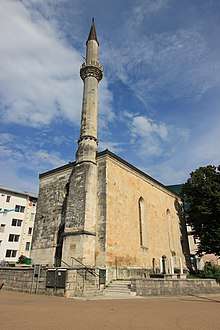 Fethija mosque (Bihać), former church of St. Anthony, 1266
Fethija mosque (Bihać), former church of St. Anthony, 1266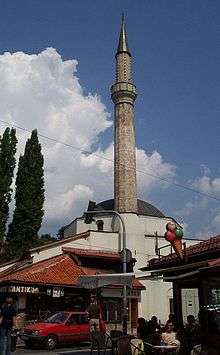
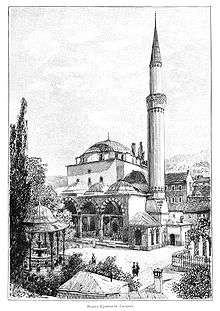 Gazi Husrev-beg Mosque, Sarajevo, 1532
Gazi Husrev-beg Mosque, Sarajevo, 1532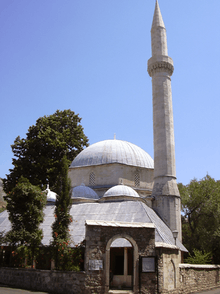 Karađoz Bey Mosque, Mostar, 1557
Karađoz Bey Mosque, Mostar, 1557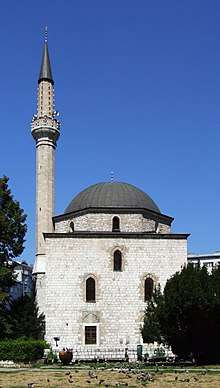
.jpg) Baščaršija Mosque, Sarajevo, 1561
Baščaršija Mosque, Sarajevo, 1561- Mosque, Počitelj, 1561
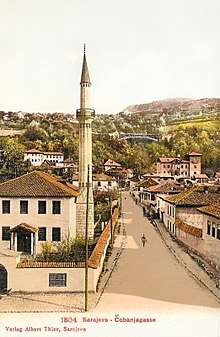 Čobanija Mosque, before 1565
Čobanija Mosque, before 1565.jpg) Emperor's Mosque, Sarajevo, rebuilt 1565
Emperor's Mosque, Sarajevo, rebuilt 1565.jpg)
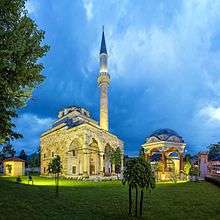 Ferhat Pasha Mosque in Banja Luka, 1579 (rebuilt 2016)
Ferhat Pasha Mosque in Banja Luka, 1579 (rebuilt 2016)- Mosque, Mostar, 1617
.jpg) Wooden mosque, Tuzla, from the 18th century
Wooden mosque, Tuzla, from the 18th century
The Austro-Hungarian era
After the 1878 Congress of Berlin, Bosnia and Herzegovina came under the control of Austria-Hungary. In 1908, Austria-Hungary formally annexed the region.
Bosnia, along with Albania and Kosovo were the only parts of the Ottoman Empire in the Balkans where large numbers of people were converted to Islam, and remained there after independence. In other areas of the former Ottoman Empire where Muslims formed the majority or started to form the majority, those Muslims were either expelled, assimilated/Christianized, massacred, or fled elsewhere (Muhajirs).
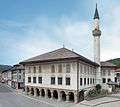 Mosque, Travnik, constructed 1815
Mosque, Travnik, constructed 1815.jpg) Bosnian Madrasa ca. 1906
Bosnian Madrasa ca. 1906.jpg) Mosque, Cazin, ca. 1906
Mosque, Cazin, ca. 1906 Bosniak military imam in the Austro-Hungarian Army
Bosniak military imam in the Austro-Hungarian Army
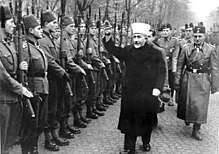
The Yugoslav period and World War Two
The war in Bosnia and Herzegovina
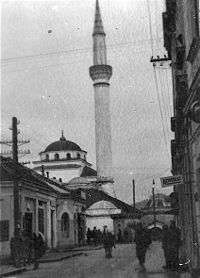
The ethnic cleansing of Bosnian Muslims during the Bosnian war caused a profound internal displacement of their population within Bosnia-Herzegovina, resulting in the almost complete segregation of the country's religious communities into separate ethno-religious areas. The rate of returning refugees was markedly slowed down by 2003-2004, leaving the majority of Serbian Orthodox adherents living in the Republika Srpska and the majority of Muslims and Catholics still living in the Federation of Bosnia and Herzegovina. Within the Federation, distinct Muslim and Catholic majority areas remain. However, the return of Serbian Orthodox adherents and Muslims to their prewar homes in Western Bosnia Canton and Muslims to their prewar homes in eastern Bosnia near Srebrenica have shifted the ethno-religious composition in both areas.
Throughout Bosnia, mosques were systematically destroyed by Serb and Croat armed forces. Among the most important losses were two mosques in Banja Luka, Arnaudija and Ferhadija mosque, which were on the UNESCO register of world cultural monuments.
| Building | Destroyed | Damaged | Total | |||||||||||
|---|---|---|---|---|---|---|---|---|---|---|---|---|---|---|
| by Serb extremists | by Croat extremists | by Serb extremists | by Croat extremists | Total destroyed during the war | Total damaged during the war | Total | Total no. before the war | Percentage of pre-war damaged or destroyed | ||||||
| congregational mosque (Džamija) | 249 | 58 | 540 | 80 | 307 | 620 | 927 | 1.149 | 81% | |||||
| small neighbourhood mosque (Mesdžid) | 21 | 20 | 175 | 43 | 41 | 218 | 259 | 557 | 47% | |||||
| Quran schools (Mekteb) | 14 | 4 | 55 | 14 | 18 | 69 | 87 | 954 | 9% | |||||
| Dervish lodges (Tekija) | 4 | 1 | 3 | 1 | 5 | 4 | 9 | 15 | 60% | |||||
| Mausolea, shrines (Turbe) | 6 | 1 | 34 | 3 | 7 | 37 | 44 | 90 | 49% | |||||
| Buildings of religious endowments (Vakuf) | 125 | 24 | 345 | 60 | 149 | 405 | 554 | 1.425 | 39% | |||||
| Total | 419 | 108 | 1,152 | 201 | 527 | 1,353 | 1,880 | 4,190 | 45% | |||||
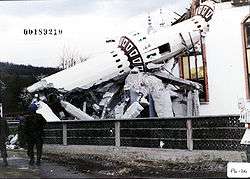 Mosque destroyed during the Ahmići massacre 1993
Mosque destroyed during the Ahmići massacre 1993 Muslim gravestones at the Potočari genocide memorial near Srebrenica
Muslim gravestones at the Potočari genocide memorial near Srebrenica Gravemarker of a 13-year-old Muslim boy killed in the Srebrenica massacre 1995
Gravemarker of a 13-year-old Muslim boy killed in the Srebrenica massacre 1995 Muslim cemetery, Sarajevo
Muslim cemetery, Sarajevo
The post-war period
Many religious buildings were destroyed in the war during the 90s and mosques were rebuilt with the aid of funds from Saudi Arabia and other countries from the Middle and far East, leading to a growing influence of the Wahhabi movement in Bosnia in the late 1990s.[8]
Historically, Bosnian Muslims had always practiced a form of Islam that is strongly influenced by Sufism. Since the Bosnian War, however, some remnants of groups of foreign fighters from the Middle East, fighting on the side of Bosnian Army, remained for some time and attempted to spread Wahhabism among locals. This created friction between local Muslim population, steeped in their own traditional practice of the faith, and without any previous contact with this strain in Islam, and these newly formed communities. Although these communities were relatively small and restricted to a certain number of villages around central and northern Bosnia, the issue was highly politicized and also caused conflict within the Bosniak society itself.[9][10]
- King Fahd Mosque in Sarajevo (2000)
 Istiklal Mosque in Otoka, Sarajevo (2001)
Istiklal Mosque in Otoka, Sarajevo (2001)- Post-war Islamic centre and mosque, Bugojno
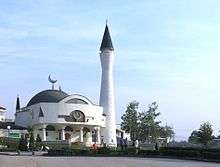 New mosque of Kakanj
New mosque of Kakanj New mosque, Orašje Planje, 2011
New mosque, Orašje Planje, 2011- Old mosque of Jajce under reconstruction (2008)
 Ferhat Pasha Mosque in Banja Luka, 1579 (rebuilt 2016)
Ferhat Pasha Mosque in Banja Luka, 1579 (rebuilt 2016)
Between secularism and religious revival
For a majority of Bosniaks that identify themselves as Muslims, religion often serves as a community linkage, and religious practice is confined to occasional visits to the mosque (especially during Ramadan and the two Eids) and significant rites of passage such as 'aqiqah, marriage, and death. Headscarves for women, or the hijab, is worn only by a minority of Bosniak women, and otherwise mostly for religious purpose (such as the çarşaf for prayer and going to the mosque). Bosnians who participate in or are children of ethnically mixed marriages between the Bosniak, Serbian and Croatian populations in Bosnia and Herzegovina are usually atheist, although in some cases one of the two spouses converts to the confession of the other.
Religious leaders from the three major faiths claim that observance is increasing among younger persons as an expression of increased identification with their ethnic heritage, in large part due to the national religious revival that occurred as a result of the Bosnian war.[11] Leaders from the three main religious communities observed that they enjoy greater support from their believers in rural areas of Bosnia and Herzegovina rather than urban centres such as the capital Sarajevo or Banja Luka.[11] On the other hand, however, the violence and misery caused by religious conflict has led other Bosnians to reject religion altogether. This atheist community faces discrimination, and is frequently verbally attacked by religious leaders as "corrupt people without morals".[12]
In a 1998 public opinion poll, 78.3% of Bosniaks in the Federation of Bosnia and Herzegovina declared themselves to be religious.[13]
In Bosnia and Herzegovina, there are eight muftis located in major municipalities across the country: Sarajevo, Bihać, Travnik, Tuzla, Goražde, Zenica, Mostar, and Banja Luka. The head of the Islamic Community of Bosnia and Herzegovina is Husein Kavazović.[14]
See also
| Wikimedia Commons has media related to Islam in Bosnia and Herzegovina. |
References
- ↑ "CIA – The World Factbook – Bosnia and Herzegovina". Cia.gov. Retrieved 4 January 2018.
- ↑ "The World's Muslims: Unity and Diversity" (PDF). Pew Research Center. 2012. p. 30. Retrieved 7 April 2016.
- ↑ "EKSKLUZIVNO- N1 sa dervišima: Pogledajte rijetko viđene snimke mističnih obreda". Ba.n1info.com. Retrieved 4 January 2018.
- ↑ "Freedom of religion Law..., Official Gazette of B&H 5/04" (PDF). Mpr.gov.ba. Retrieved 4 January 2018.
- ↑ Bašić, Denis (2009). The roots of the religious, ethnic, and national identity of the Bosnian-Herzegovinan [sic] Muslims. University of Washington. ISBN 9781109124637.
- ↑ Malcolm 1995, p. 71.
- ↑ Maya Shatzmiller (2002). Islam and Bosnia: Conflict Resolution and Foreign Policy in Multi-Ethnic States. Queens University School of Policy. p. 100.
- ↑ "Kaliber 5 juni 2005: Saudiarabisk mission i Sverige". Sveriges Television. 20 November 2005. Retrieved 13 March 2017.
- ↑ "Radical Islamists Seek To Exploit Frustration In Bosnia". Rferl.mobi. Retrieved 14 June 2016.
- ↑ "Bosnia's Wartime Legacy Fuels Radical Islam :: Balkan Insight". Balkaninsight.com. Retrieved 14 June 2016.
- 1 2 "Bosnia and Herzegovina: International Religious Freedom Report 2006". U.S Department of State—Bureau of Democracy, Human Rights, and Labor. 2006-09-15.
- ↑ Dubensky, Joyce S. (2016). Peacemakers in Action: Profiles in Religious Peacebuilding. Cambridge: Cambridge University Press. p. 391. ISBN 9781107152960. Retrieved 4 January 2018.
- ↑ Velikonja, Mitja (2003). Religious separation and political intolerance in Bosnia-Herzegovina. Texas A&M University Press. p. 261. ISBN 1585442267. Retrieved 6 January 2011.
- ↑ "Islamska zajednica u Bosni i Hercegovini - Početna". Rijaset.ba. Retrieved 14 June 2016.
